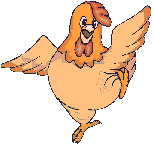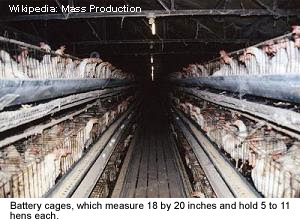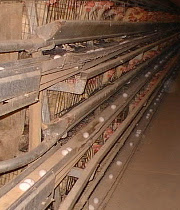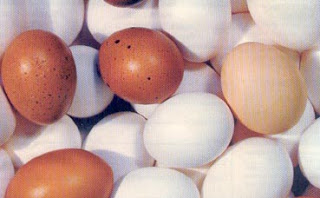The Egg-ly Truth

This morning as I was going about my usual chores, I was thinking about my hens and the life that they lead. I thought about how each morning, I throw them our food scraps and a few scoops of scratch, scrub out their heated water buckets and refill them with fresh water, clean the previous night’s accumulations of poop from their roosting areas and nesting boxes and fill their feeders up to the top. The doors to their coops are opened wide so that fresh air fills the coop.
The hens rush out of doors to their yard which has a soft layer of hay. They spend their mornings pecking and scratching thru the hay for tasty treats, fraternizing with the roosters, and laying eggs in the nesting boxes.
This gal needs occasional beak maintenance....see how she grows it into two points? I trim it with scissors, or else she would starve. |
Around noon, their outside gate is opened and they are allowed access to the rest of the farm. Out they pour....some to the pasture, some to the woods, some to the goat pens. They hunt for insects and bathe in the dust and explore the compost pile.
By nightfall, they have found their way back to the coops and climbed onto their roosts for a peaceful night’s slumber.
It’s a good life for a chicken; and one we are committed to providing. In return, these gentle creatures provide us with plentiful, nutritious eggs that are free from disease and hours of comic relief.
Presently, we have about 70 chickens. They all enjoy the same clean and healthy life in several coop/yard setups.
First, let me tell you....I have not always lived this type of life. I have worked towards this goal for the past several years. Prior to that, I lived in suburbia and bought my food at the supermarket. I read labels, not understanding what most of the words meant. I tried to shop with a conscience. But I was ignorant, clueless, uninformed. Unfortunately, most of the populace is uninformed as I was. Most believe what they see in print...searching out egg cartons with words like “organic”, “free range”, “cage- free” and “nest-laid” thinking that those chickens have been raised humanely; and that somehow those eggs will be more nutritious or disease free.
Sadly, as with most advertising, those words are meaningless and misleading. The majority of chickens are raised in poultry houses such as this.

They are referred to as protein factories, with no thought being given to the life of the chicken.
These birds spend their lives in confined spaces, standing in their own excrement with no exercise. They become aggressive and fight with each other for space. To prevent cannibalism, their beaks are often cut off. These birds are stressed and diseased. Antibiotics are used to prevent the chickens from succumbing to these diseases. Their quarters are not cleaned until the birds are removed from the poultry house. They usually live under these conditions for two years and then are sold at auction for eventual butchering. For the most part, they never see the light of day or feel a breeze blow through their feathers, until they are shoved into a tractor trailer and sent to the rendering plant.

The recent salmonella outbreaks have forced us to take a hard look at our egg production. Interestingly, when the FDA and department of Agriculture investigated this country’s egg production, they came to the conclusion that part of the problem must be the fact that birds and rodents can get into the poultry houses, thus introducing harmful bacteria. I have to admit I found this conclusion quite comical. As usual, they missed their mark. They may have identified a contributing factor, but the cause is simple. Simply stated, the cause of these disease outbreaks is entirely due to the living conditions of the birds. You must understand, my chicken houses are frequented daily by visiting birds and mice...looking for free food and shelter. These tiny creatures pose no threat to my chickens, who are healthy and stress- free. The bacteria that normally live within the digestive and genitourinary tracts of the chickens pose no threat to my chickens either for the same reason. Protein factory chickens are a different story...they are weak and sickly with little or no immune system.


So, “what about free range and cage-free chickens?” you ask. The truth is, this picture is an illustration of what is considered “free ranging” and “cage-free”(yes, that has been determined by the governmental agencies that are responsible for protecting consumers)...

These chickens have access to a very small outside yard at one end of the chicken house. Unfortunately, they are packed in so tightly, that only a few chickens who are right beside that little door even know it exists, not to mention being the only ones who could gain access to that door. So, like caged birds, they stand in their own excrement, peck each other to death....living nightmarish lives that no creature should have to endure. “Nest-laid” eggs are produced under the same conditions...with nesting boxes available to the chickens around the perimeter of the poultry house. It is suggested, but not demanded that these chickens have a little hay thrown to them.
As for “organic” eggs. That label says nothing about the living conditions of the chickens, only that they were fed organic feed and given no antibiotics.
Pretty grim stuff, isn’t it? Unfortunately this is just the tip of the iceberg when it comes to the subject of our food and how it is produced. I could go on and on, as this is a subject about which I am passionate. But, I will stay on the subject of eggs for now.

By now you are probably wondering what you can do about this problem. As Hubbs always says...”vote with your checkbook”. Don’t buy commercially produced eggs. Find a farm that raises chickens out of doors and buy your eggs from them. Buy at your local farmer’s market...but don’t be fooled. Ask to see how those eggs are produced. Make sure they don’t come from large industrial chicken houses. Or, if you have a little space of your own...buy a few chickens and start your own small backyard flock. You would be amazed at how little time and money are needed to keep a small flock of egg layers.
If you question the difference between store bought and farm raised eggs, I will tell you that they are worlds apart...both in looks and flavor. A farm raised egg has a bright orange yolk and much richer flavor. As for freshness, what you buy in the supermarket may be as old as one month before you bring it home. While eggs do last a long time, wouldn't you rather eat one that is fresher? Not to mention more nutritious? Hens who have access to pasture and insects lay eggs that are overall more nutritious and higher in Omega 3 fatty acids.
I challenge you to consider this and perhaps find a farmer who would be willing to supply you with farm fresh eggs. I guarantee you will never go back to store bought. Or, better yet...consider adding a few chickens to your acreage. Don't hesitate to email me if you have any questions.
If you are interested in doing a bit of reading about our food and where it comes from, I can give you several recommendations.
If you question the difference between store bought and farm raised eggs, I will tell you that they are worlds apart...both in looks and flavor. A farm raised egg has a bright orange yolk and much richer flavor. As for freshness, what you buy in the supermarket may be as old as one month before you bring it home. While eggs do last a long time, wouldn't you rather eat one that is fresher? Not to mention more nutritious? Hens who have access to pasture and insects lay eggs that are overall more nutritious and higher in Omega 3 fatty acids.
I challenge you to consider this and perhaps find a farmer who would be willing to supply you with farm fresh eggs. I guarantee you will never go back to store bought. Or, better yet...consider adding a few chickens to your acreage. Don't hesitate to email me if you have any questions.
If you are interested in doing a bit of reading about our food and where it comes from, I can give you several recommendations.
- Growing Chickens
I am happy to say that the hens that arrived as just-hatched-chickson April 1st are laying now. Every day I am getting 2 ½ to 3 dozen eggs. Lovely, aren't they?I love an egg carton full of eggs of varied color and size. Hubbs takes our eggs to...
- I Need An Answer
I have a question for you...something that has me worried. Here it is..... At what point does one qualify to be labeled a chicken hoarder? Seriously, I know I am not a hoarder,but my flock seems to be growing as the years pass. My problem is this.......
- Faq
I had a few questions regarding my last post and raising chickens. If you are interested in raising chickens, a little research into breeds will tell you what type you prefer. Every different breed has a different egg. There are even chickens who lay...
- The Long And The Short Of Egg Production
Currently, we have about 30 layers....producing about 15 (plus or minus) eggs a day. We have a dozen more Rhode Island Red adolescents that will begin to lay later this winter. The amazing thing to me is the variety of color and size that we get in any...
- To Market , To Market
Well, after months and months of waiting, our hens are finally laying enough eggs for us to market. I ordered these egg cartons and got busy with "Photo Shop" making labels for each. From here they get delivered to everyone on our "egg list". Fresh, free-ranging...
